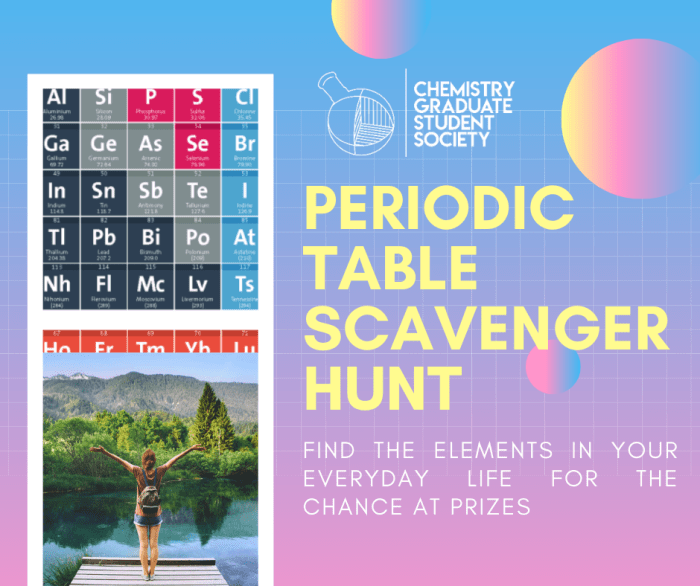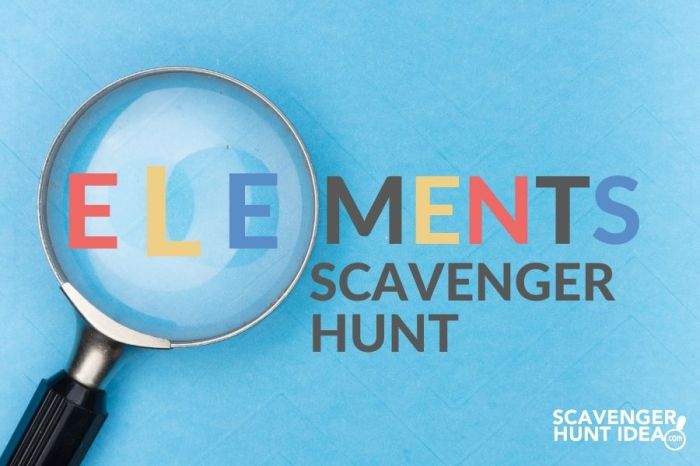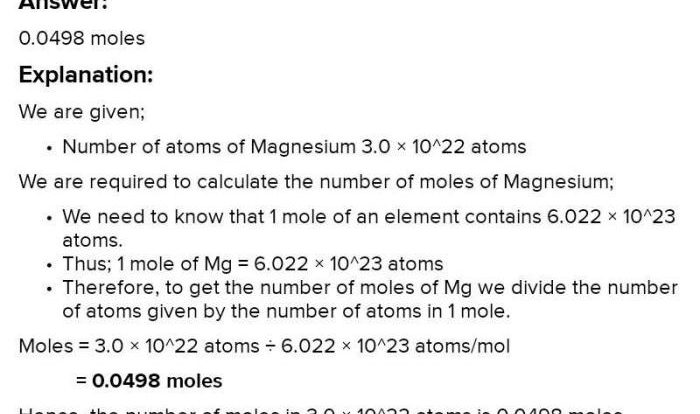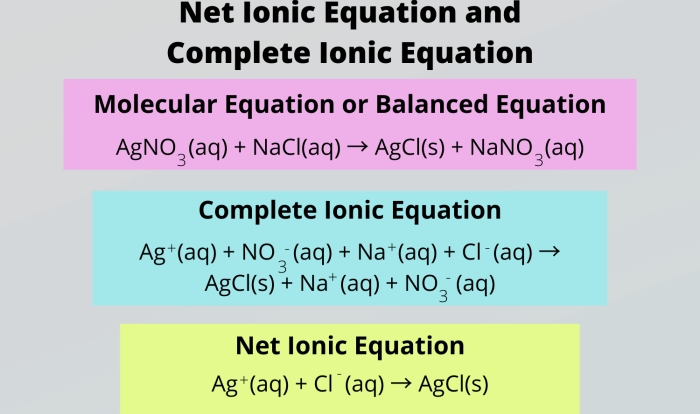Embark on the Epic Periodic Table Scavenger Hunt, an immersive and educational adventure that unravels the mysteries of chemistry. This captivating hunt guides participants through the periodic table, fostering a deep understanding of its organization, elements, and their properties.
The scavenger hunt challenges participants to decipher clues and solve puzzles, all while deepening their knowledge of atomic number, atomic mass, and electron configuration. By navigating the periodic table, participants uncover the significance of each element, gaining insights into their unique characteristics and applications.
The Elements of the Periodic Table
The periodic table is a tabular arrangement of chemical elements, organized on the basis of their atomic number, electron configurations, and recurring chemical properties. It is generally accepted that the modern periodic table was first published by Dmitri Mendeleev in 1869, although several other scientists had developed similar tables prior to this.
The periodic table is divided into 18 vertical columns, called groups, and 7 horizontal rows, called periods. The groups are numbered 1-18 from left to right, and the periods are numbered 1-7 from top to bottom. Elements in the same group have similar chemical properties, while elements in the same period have the same number of electron shells.
The periodic table can be divided into four blocks: the s-block, the p-block, the d-block, and the f-block. The s-block and p-block elements are located in the main group columns, while the d-block and f-block elements are located in the transition metal and inner transition metal columns, respectively.
Atomic Number, Atomic Mass, and Electron Configuration
The atomic number of an element is the number of protons in the nucleus of an atom of that element. The atomic mass of an element is the weighted average mass of all the isotopes of that element. The electron configuration of an element is the distribution of electrons in the atomic orbitals of an atom of that element.
The atomic number, atomic mass, and electron configuration of an element are all important factors in determining the chemical properties of that element.
The Scavenger Hunt

The periodic table scavenger hunt is a fun and educational way to learn about the periodic table and the elements that it contains. The goal of the scavenger hunt is to find all of the hidden elements on the periodic table.
To play the scavenger hunt, you will need a copy of the periodic table and a list of the hidden elements. The list of hidden elements can be found on the website of the American Chemical Society.
Once you have your materials, you can begin the scavenger hunt. To find a hidden element, simply look for the element’s symbol on the periodic table. Once you have found an element, you can cross it off of your list.
The scavenger hunt is a great way to learn about the periodic table and the elements that it contains. It is also a fun and challenging way to test your knowledge of chemistry.
Strategies and Techniques, The epic periodic table scavenger hunt
There are a number of strategies and techniques that you can use to find the hidden elements on the periodic table. One strategy is to start with the elements that you are most familiar with. Another strategy is to look for patterns in the periodic table.
For example, all of the alkali metals are located in Group 1, and all of the halogens are located in Group 17.
You can also use the electron configuration of an element to help you find it on the periodic table. The electron configuration of an element tells you the number of electrons that the element has in each of its electron shells.
The electron configuration of an element can be found on the periodic table or in a chemistry textbook.
The Rewards of the Hunt
The periodic table scavenger hunt is a great way to learn about the periodic table and the elements that it contains. It is also a fun and challenging way to test your knowledge of chemistry.
In addition to being a fun and educational activity, the periodic table scavenger hunt can also be a rewarding experience. By completing the scavenger hunt, you will learn more about the periodic table and the elements that it contains. You will also develop your problem-solving skills and your ability to think critically.
The periodic table scavenger hunt is a great activity for students of all ages. It is a fun and engaging way to learn about chemistry and the periodic table.
How the Hunt Can Be Used to Engage Students in the Learning Process
The periodic table scavenger hunt can be used to engage students in the learning process in a number of ways. For example, the scavenger hunt can be used as a review activity after a unit on the periodic table. It can also be used as a way to introduce new concepts, such as electron configuration and atomic mass.
The periodic table scavenger hunt is a versatile activity that can be adapted to fit the needs of any classroom. It is a fun and engaging way to learn about chemistry and the periodic table.
The Epic Journey
The periodic table scavenger hunt is an epic journey that takes you through the world of chemistry. Along the way, you will learn about the elements that make up our world and the properties that make them unique.
The scavenger hunt is divided into four steps, each of which takes you deeper into the world of chemistry. In the first step, you will learn about the basics of the periodic table, including the groups, periods, and blocks. In the second step, you will learn about the different types of elements and their properties.
In the third step, you will learn about the electron configuration of elements and how it affects their chemical properties. In the fourth and final step, you will put your knowledge to the test by completing a challenging puzzle.
The periodic table scavenger hunt is a fun and educational way to learn about chemistry. It is also a great way to test your knowledge of the periodic table and the elements that it contains.
| Step | Time Frame | Resources | Challenges |
|---|---|---|---|
| 1. The Basics of the Periodic Table | 1 hour | Periodic table | Understanding the groups, periods, and blocks |
| 2. The Different Types of Elements | 1 hour | Periodic table | Learning about the different types of elements and their properties |
| 3. The Electron Configuration of Elements | 1 hour | Periodic table, chemistry textbook | Understanding the electron configuration of elements and how it affects their chemical properties |
| 4. The Grand Finale | 1 hour | Periodic table, chemistry textbook | Completing a challenging puzzle |
The Grand Finale

The grand finale of the periodic table scavenger hunt is a challenging puzzle that will test your knowledge of the periodic table and the elements that it contains. To solve the puzzle, you will need to use your knowledge of the periodic table to identify the elements that are represented by the symbols in the puzzle.
Once you have identified the elements, you will need to use your knowledge of their chemical properties to solve the puzzle. The puzzle may require you to use your knowledge of the elements’ atomic numbers, atomic masses, electron configurations, or chemical properties.
The grand finale is a challenging puzzle, but it is also a fun and rewarding way to test your knowledge of the periodic table and the elements that it contains.
Possible Puzzles
There are many different types of puzzles that could be used for the grand finale of the periodic table scavenger hunt. Some possible puzzles include:
- Crossword puzzles
- Word searches
- Anagrams
- Sudoku puzzles
- Logic puzzles
The type of puzzle that you choose will depend on the age and ability level of your students.
Helpful Answers: The Epic Periodic Table Scavenger Hunt
What is the purpose of the Epic Periodic Table Scavenger Hunt?
The scavenger hunt aims to foster a deep understanding of the periodic table, its organization, and the properties of its elements.
How does the scavenger hunt help participants learn about chemistry?
By engaging in the hunt, participants actively explore the periodic table, uncovering the relationships between elements and their properties.
What skills can participants develop through the scavenger hunt?
In addition to chemistry knowledge, participants develop critical thinking, problem-solving, and analytical skills.


